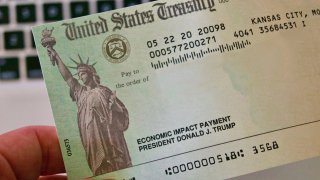
- "I am asking Congress to amend this bill and increase the ridiculously low $600 to $2,000, or $4,000 for a couple," Trump said in a video posted to Twitter Tuesday night.
- The legislation passed both houses of Congress with veto-proof majorities, meaning that Trump is powerless to raise direct payments from $600.
President Donald Trump is demanding lawmakers raise the second round of stimulus checks to $2,000 per person, from $600.
"I am asking Congress to amend this bill and increase the ridiculously low $600 to $2,000, or $4,000 for a couple," Trump said in a video posted to Twitter Tuesday night.
While the president did not outright threaten a veto of the $900 billion Covid relief bill, he did call it an unsuitable "disgrace."
But if you are one of the people eligible for a stimulus check, don't get your hopes up. The legislation passed both houses of Congress with veto-proof majorities, meaning that Trump is powerless to raise direct payments from $600.
Still, the top Democrats in Congress, House Speaker Nancy Pelosi and Senate Minority Leader Chuck Schumer, said they would support getting bigger checks to people.
Money Report
"Democrats are ready to bring this to the Floor this week by unanimous consent. Let's do it!" Pelosi tweeted.
A senior Democratic aide told CNBC that House Democrats will attempt to pass a standalone bill for $2,000 direct payments on Thursday, though it is unclear whether this would pass a Republican-led Senate, or even receive the unanimous consent necessary in the House.
Lawmakers calling for a vote on this standalone measure have not specified whether this would be in addition to the $600 second stimulus check, or would instead replace it.
For now, here is what we know about the stimulus money that is currently guaranteed in the new relief package.
Who's eligible
The pandemic recovery bill includes direct payments of up to $600 to eligible adults, plus $600 per child dependent.
While the adult benefit is half the size of the first stimulus check, the amount earmarked for qualifying dependents was raised by $100. At the full benefit amount, a family of four could potentially receive $2,400.
Those qualifying for the maximum stimulus payment include individuals earning up to $75,000 in adjusted gross income, or $112,500 as head of household and $150,000 as a married couple filing jointly.
Payments are reduced at the same rate as the CARES Act checks. For every $100 earned over these income thresholds, payments are docked $5. However, the AGI caps are lower this time.
Individuals with $87,000 in income and married couples who file jointly earning $174,000 will not receive any payment. Therefore, fewer people will qualify for payments, and those who do receive a check, will be getting a lot less than the first round of direct payments.
When you'll get it
First in line will likely be individuals who already have their direct payment information on file with the IRS.
Treasury Secretary Steven Mnuchin told CNBC on Monday that qualifying Americans could see direct payments reach their bank accounts in a matter of days.
"This is a very, very fast way of getting money into the economy. Let me emphasize: People are going to see this money at the beginning of next week," Mnuchin told CNBC host Jim Cramer.
That includes those who signed up to receive a refund by direct deposit when filing their 2018 and/or 2019 taxes, and it may also extend to the 14 million people who previously registered their details via two new online tools the IRS built this spring to collect banking and contact information.
For those who are eligible for a stimulus payment but have not shared their bank account details with the IRS, they can expect to instead receive a paper check or a prepaid debit card.
The Treasury has the capacity to deliver five to seven million paper checks a week, in addition to checks for other federal programs. IRS and Treasury could again prioritize the mailing of the second stimulus checks to the country's lowest-income earners, starting with individuals making less than $20,000 per year.
Still no $1,200 stimulus check?
Keep in mind, there are still people waiting for all or part of their first Covid relief payment. Tax experts say it is not too late to request that cash.
"They can get the stimulus payment they are eligible for in the form of a Recovery Rebate Credit when they file their 2020 taxes," said Lisa Greene-Lewis, certified public accountant and TurboTax expert.
The payments included up to $1,200 per individual or $2,400 per married couple, plus $500 per child under 17. The tax credit would either lower the amount of tax you need to pay, or increase the value of your tax refund.
The easiest way for a taxpayer to get a stimulus payment, or additional payment — if they are, in fact, due more — is to apply on their 2020 tax return, explained Mark Steber, chief tax officer for Jackson Hewitt Tax Services.
"There will be a schedule and line on the tax return to reconcile what they have received so far, and the amount actually due to them based on their 2020 tax return," continued Steber.
The IRS says that eligible individuals can claim the Recovery Rebate Credit on their 2020 Form 1040 or 1040-SR. These forms can also be used by people who are not normally required to file tax returns but are eligible for the credit.
For those concerned about how this might complicate the filing process this year, Greene-Lewis tells filers not to worry because automated tax preparation software will factor this in for you.
"TurboTax has guidance related to stimulus payments and other impacts of Covid-19," explained Greene-Lewis. "It will ask up front if the filer received a stimulus payment and then calculate the Recovery Rebate Credit based on actual 2020 income."
Whatever your circumstances, tax experts agree that filing early will be an especially good idea this year.
SIGN UP: Money 101 is an 8-week learning course to financial freedom, delivered weekly to your inbox.
Disclosure: NBCUniversal and Comcast Ventures are investors in Acorns.






